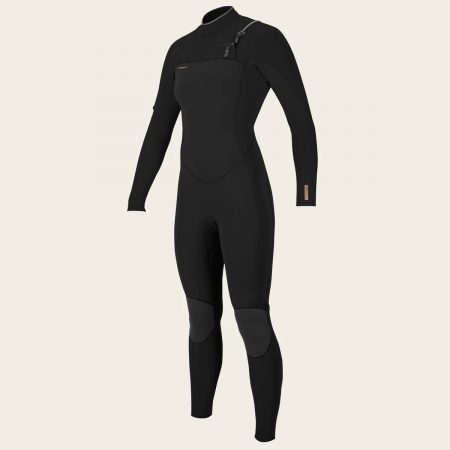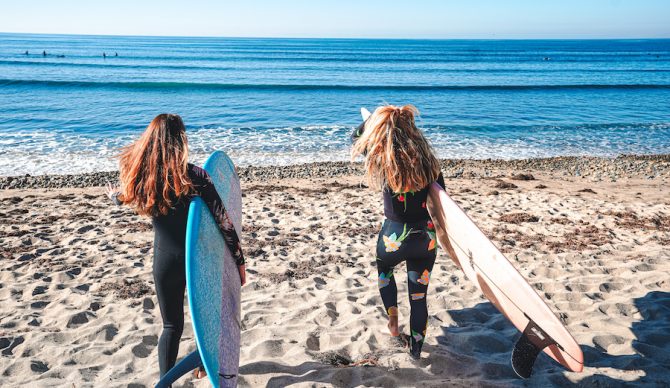
Interested in staying warm? Look no further. Kelin Victoria//The Inertia
In a male-dominated sport such as surfing, it can be difficult to find gear specifically tailored to women. Luckily, the women’s surf industry has grown tremendously in the past decade. And after a lot of testing, it’s safe to say that the current state of women’s wetsuits is impressive. All the suits included in this review are suits we’d feel comfortable recommending to a friend or family member for their cool and cold-water adventures.
Our lead testers have been surfing for more than four decades combined, and as a team, we continue to research the latest and greatest in women’s wetsuit trends and technologies to keep this article as current as possible. Over the past couple of years, we’ve tested more than 30 of the top women’s wetsuits on the market to bring you the best of the best.
Navigate To: Comparison Table | Buyer’s Guide
Related: Best Men’s Wetsuits | Best Wetsuit Booties | Surf Gear Reviews
The Best Women’s Wetsuits of 2025
Best Overall Women’s Wetsuit: Billabong Furnace Natural
Runner-Up Best Overall Women’s Wetsuit: O’Neill Hyperfreak Fire
Most Sustainable Women’s Wetsuit: Patagonia Regulator
Best Value Women’s Wetsuit: Roxy Prologue
Most High-Performing Women’s Wetsuit: Xcel Comp+
Best Overall Women’s Wetsuit
Billabong Furnace Natural ($400)
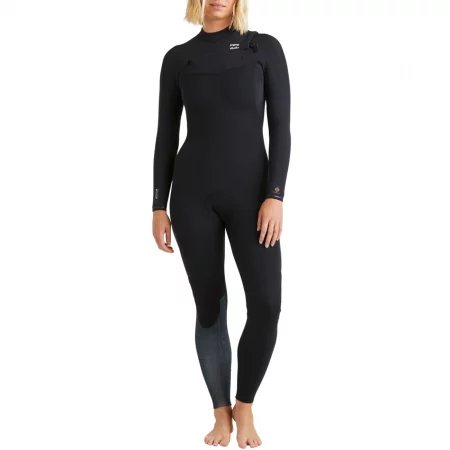
Available In: 4/3mm, 5/4 hooded
Materials: Natural Hevea rubber, 100% recycled textiles for inner and outer lining
Features: Sustainable natural rubber, exterior seam seal, key loop in chest zip
Pros: Lightweight, stretchy, warm, and stylish
Cons: Some minor leakage in the chest
Living up to its name, Billabong’s Furnace Natural wetsuit is a buttery experience that combines comfort, style, warmth, and flexibility. For those who value warmth and practicality in a wetsuit, this one did not disappoint. To reduce its environmental impact, Billabong has made a significant shift in using FSC-certified natural rubber found in Hevea trees in their wetsuits. Though some brands tout sustainability, the trade-off is often stretch and weight, and this is why The Furnace Comp scored a top rank. The suit never felt heavy, no matter how long the tester used it. Whether it was a 30-minute or a two-hour session, the rubber felt lightweight and restriction-free, allowing our tester to last longer in the water, including paddling, navigating the lineup, and catching waves.
This ranking was a close call to the O’Neill Hyperfreak fire, as, by reputation, the O’Neill suits tend to offer more flexibility and warmth. Our tester kept reaching for both suits, but ended up with the Billabong for its lightweight material. Additionally, the inner lining wasn’t as tight around her neck as the O’Neill, though it did let some water in through the chest/neck area as a result.
The graphene-infused lining extends across the chest and the back, where heat conservation matters most, keeping surfers consistently warm. And despite the colder-than-average water temperatures in Southern California this season, the 3/2 Furnace kept body heat contained while remaining quite flexible.
Flexibility is where this suit really shines. Billabong strategically uses a lightweight material, or its Airlite 4D exterior and a Smart foam core for unrestricted paddling, which comes in handy anywhere north of Orange County’s Santa Ana Rivermouth. The stretch factor made it easy to stay active for hours without feeling fatigued. An added plus that our tester is most elated about: this suit did not feel restrictive, no matter the body curves – the Billabong Furnace adjusted and did not pinch in areas that required a little extra stretch.
Our tester also loves to surf Trestles, and there’s quite a walk to the beach, so one of the big bonuses about this suit is the soaking wet weight. Out of all the wetsuits tested, the Billabong Furnace was also on the lighter side, weighing at just over two pounds wet, making it a great option to pack in any day pack when walking a ways to the beach. The O’Neill also shone in this area, but held a little more water, which ended up at the bottom of her pack. Read our full review of the Billabong Furnace Natural here.
Check Price on Backcountry Check Price on Cleanline Surf
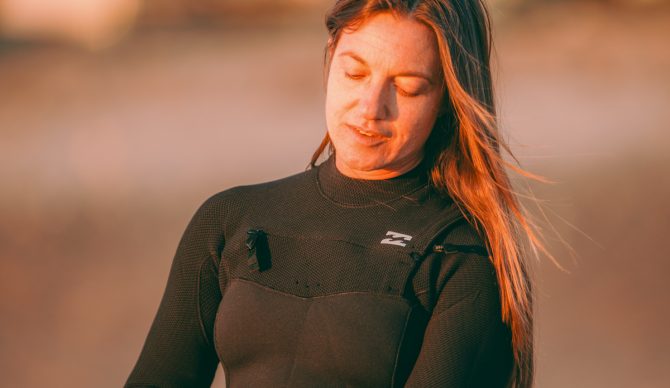
Photo: Jackie Connor//The Inertia
Runner-Up Best Overall Women’s Wetsuit
O’Neill Women’s Hyperfreak Fire ($440)
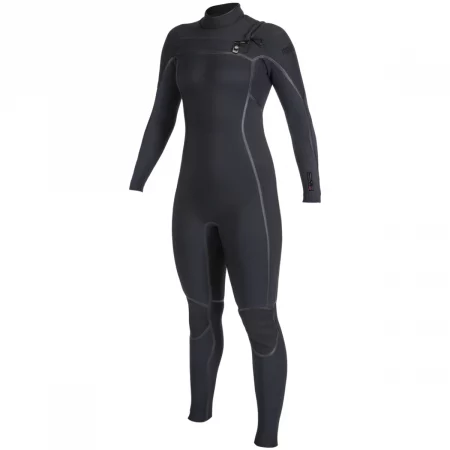
Available in: 3/2mm+, 4/3mm+
Materials: Limestone neoprene made with recycled oyster shells and eco carbon black, recycled materials used in wetsuit lining
Features: Extra .5mm of thickness, exterior sealed seams, key pocket on calf
Pros: Very warm and flexible
Cons: No hood, odd pinching in thighs, neck is too small
The O’Neill Hyperfreak Fire wetsuit offers a primo experience for those who need both flexibility and warmth in the water. Incorporated with Technobutter 4x (TB4) technology, or recycled graphene fibers into its latest heat technology, the Hyperfreak Fire creates an easy paddling, surfing, and waiting for waves experience.
Compared to its older sibling, the Hyperfreak (featured below), the Hyperfreak Fire is focused more on warmth, though it is missing the hood option that the Hyperfreak offers. The TB4 firewall layer heats up from body heat and conducts the heat back to the body, essentially creating a warmth cycle. The added layer did feel as though it stuck to our tester’s skin after a while; it almost felt as though it was holding itself in place with little rubber stoppers located at the wrists and ankles, but the suit overall was easy to manage and take off as needed. Even as our tester watched the water temps drop, the only parts of her body that felt the chill were her head, hands, and feet.
Regarding flexibility, it was a tough call between the Hyperfreak Fire and Xcel’s Comp+, though the Hyperfreak Fire is one of the most flexible suits available, the added layer of fiber made this suit feel slightly more restrictive than Xcel’s Comp+, but with the caveat that surfers will last longer in chillier water.
The silicone-based urethane sealed exterior and triple-glued, blind-stitched interior make this wetsuit very flexible, despite the added firewall. The exterior seals run parallel to the hands and arms and help minimize water entry, making it a very comfortable experience. It’s hard to consider this a proper 3/2mm suit with the added firewall layer, and our tester knocked O’Neill’s Hyperfreak Fire for calling itself a 3/2 millimeter, though in reality, it’s a 3.5/2.5mm, which O’Neill calls a “3/2+”. Compared to Billabong’s Furnace Natural, the wetsuit fibers had a rougher, less comfortable feel, and the neck was a little tighter as well, which edged it out of the top spot.
The chest zip is a free-floating zipper panel and is equipped with an anti-flush barrier speckled with drain holes to keep water from freezing your top half. Not too many complaints on the curvier side of things – this suit felt like it molded to our tester’s contours as needed, though there was some odd pinching in her thighs. The good news: no flushing and surprisingly flexible for how warm this suit is.
Check Price on Evo Check Price on Cleanline Surf
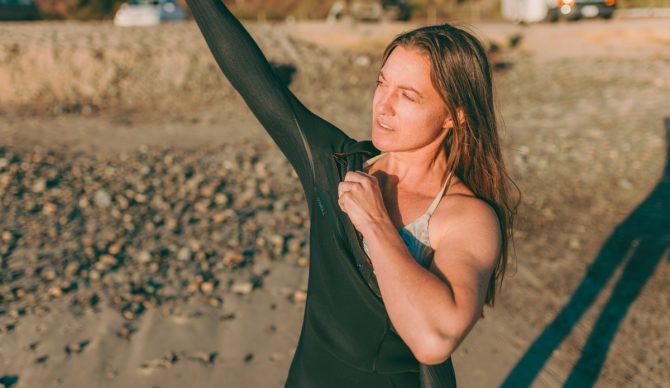
Photo: Jackie Connor//The Inertia
Most Sustainable Women’s Wetsuit
Patagonia Women’s Regulator (R2) ($509)
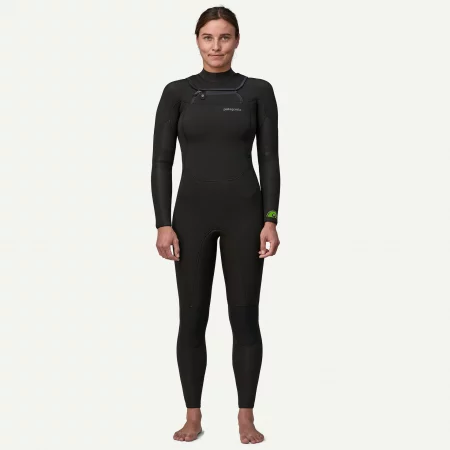
Available In: R1 (3mm/2.5mm), R2 (3.5mm/3mm), R3 (4.5mm/3.5mm), R4 (5.5mm/4mm)
Materials: Yulex Natural Rubber, 100% recycled nylon
Features: Free-floating front zipper, key loop in front zip, Patagonia repair policy
Pros: Warm, flexible, eco-friendly material, Patagonia repair policy
Cons: Expensive
Never has an unusually cold fall and winter felt so warm. Patagonia’s R2 Regulator has been the ticket to a lot of our testers’ windier surf adventures. As a standout in the eco-friendly community, this suit was consistently one of the warmest due to its 0.5 millimeters of extra rubber and thermal lining – a great choice if water temps are on the colder side.
Fair Trade certified, the suit is made from 85% Yulex natural rubber that is FSC certified by the Rainforest Alliance and 15% synthetic rubber. Additional features include a front-zip entry with a key loop, flexible yet durable kneepads and cuffs, a warm thermal lining made from recycled materials, and all the external seams are 100% sealed.
The seams are triple-glued and blind-stitched to enhance durability. The asymmetrical chest zip feature keeps the chills out without restricting movement or pulling out hair. Built and tested by women surfers, this suit pays attention to curves, namely in the hips. Not once did our tester feel restricted when walking on the sand and paddling out. The suit may have been a bit tight around her neck, but that may stretch as time goes on.
Although the suit is only available in solid black, it is function at its finest. The R2 (3.5/3mm) is a bit thinner than your classic 4/3 at 3.5/3mm, but is incredibly warm. You’ll have a hard time distinguishing it from a 4/3. It’s incredibly flexible out of the gates and feels comparable to traditional neoprene (if not better).
It’s hard to compare eco-friendly suits because different suits will use different combinations of materials. Our tester had access to a Finisterre wetsuit, and comparatively, Patagonia’s felt a lot less stiff, though one caveat here: our tester doesn’t have the latest Finisterre. In comparison to the Billabong Furnace Natural, we found the Patagonia suit to be slightly less stretchy.
When compared to a neoprene wetsuit, such as the Hyperfreak Fire or the Roxy Elite, this suit can keep up, with our tester noticing minor differences between the other suits. She also noted Patagonia’s R2 suit dries a lot faster than previous iterations, which makes it very convenient during a chillier winter season.
Like all things Patagonia, we trust that this suit is well-made and will withstand the test of time. And perhaps the most sustainable aspect of the wetsuit is Patagonia’s repair policy. When the suit stops keeping the water out, instead of tossing it in the bin and buying a new one, Patagonia encourages you to send in your wetsuit for repairs, and they’ll do their best to make it seaworthy again. And the longer a wetsuit lasts, the more sustainable it is. For surfers who care about the ocean and its ecosystems, this is a great way to align values with gear.
Read our full review of the Patagonia R2 here. For colder waters, check out the R3 (4.5/3.5mm) and R4 (5.5/4mm).
check price on Patagonia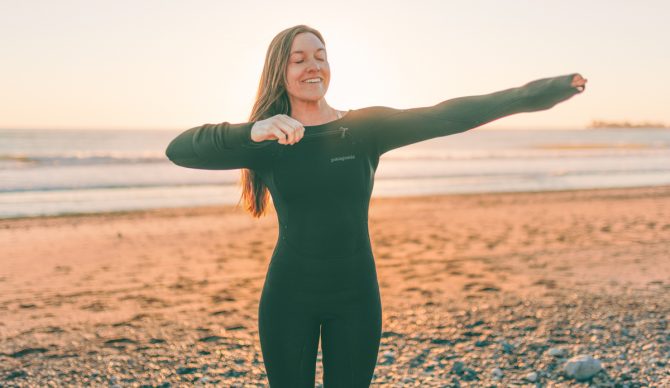
Photo: Jackie Connor//The Inertia
Best Value Women’s Wetsuit
Roxy Prologue ($230)
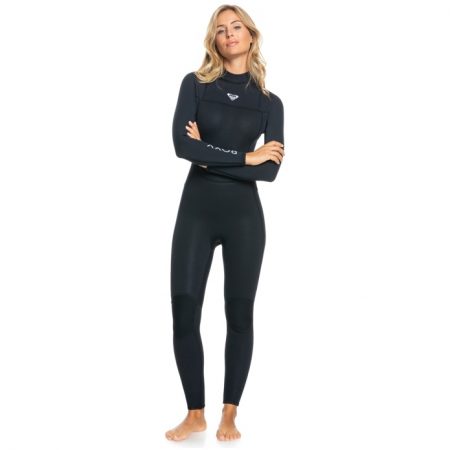
Available In: 5/4/3mm
Materials: Limestone neoprene made with recycled tires
Features: Back zip, smoothie panels on chest and back, key loop in back zip
Pros: Budget-friendly, easy entry, minimal paddle resistance
Cons: Hair catches in back zip, not super warm
With all the hype that surrounds zipperless entries, it was nice to simply step into the Roxy Prologue Backzip Wetsuit and not worry about dislocating a shoulder. This was by far the easiest and fastest wetsuit to put on and take off due to the back zip. However, it comes with a price, namely decreased warmth, and for those who are thinner blood like our tester, their session might be on the shorter side. Though definitely not the warmest wetsuit on the market, the Roxy Prologue wetsuit is lightweight, making it easier to paddle. The suit uses a combination of Freemax neoprene in the body and legs for durability and Hyperstretch 3.0 in the arms. The unique combination gives the suit its softer feel, and therefore, more flexibility and comfort.
The knee pads provide extra cushion for knee paddling if a nice day of longboarding in the sunshine is the call. The neck closure is adjustable, which, in comparison to the O’Neill Hyperfreak Fire’s tighter neck, is a welcome feature to prevent choking, albeit a fantastic trap for long hair. If you have longer hair, tie it back. The back zipper does grant the ocean easier access to creep down surfer’s spines, therefore, this may not be the best choice for those colder days. That said, we fully recommend this suit for water temperatures 63 degrees Fahrenheit and above.
When comparing the Roxy Prologue wetsuit to any other chest zip, such as its upgraded cousin, the Roxy Elite, there are different levels of warmth surfers will achieve – the chest zip is going to keep you warmer, but the back zip is a lot easier to put on and take off. In this age-old debate, ask yourself which is more important to you when purchasing a suit: time spent getting in and out of a suit or staying warm while in the water?
For those who are on a tight budget, have places to be and a limited amount of time to spend in the water, or can hang in colder climates, this wetsuit can be a great choice, saving them not only money but also time spent putting on and taking off the suit.
Check price on BACKCOUNTRY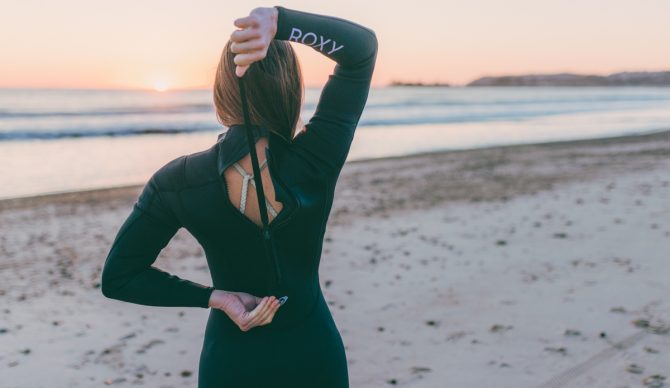
Photo: Jackie Connor//The Inertia
Best Performance Women’s Wetsuit
Xcel Women’s Comp+ ($370)
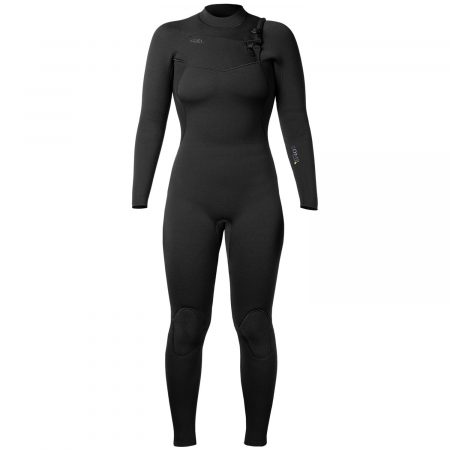
Available In: 3/2mm, 4/3mm, 5/4mm hooded
Materials: Nanoprene Light Japanese limestone neoprene, dope-dyed yarn
Features: Key loop in front zip, lightweight thermal lining throughout
Pros: Lightweight, flexible, smooth panel
Cons: Thinner lining, odd leakage around the shoulder
The waves were good, and crowds were miraculously thin at Trestles, and our tester was prepared for a longer surf sesh with her Xcel Women’s Comp+. Though performance suits might sacrifice heat over flexibility, our tester thought maybe it was the suits’ Japanese limestone nano neoprene that distracted her from the cold water. It is the most comfortable of all suits.
The orange-striped wetsuit interior does more than just look cool: it is a water-wicking, thermo-drying infrared neoprene that keeps body temperatures warmer via heat capture. It then recycles the heat, though this suit’s purpose is not as much warmth as it is performance. But even with chillier temperatures, our tester still stayed fairly warm and comfy. That said, if feeling toasty is the goal, check out Xcel’s Drylock.
This suit’s minimal seams and higher stretch materials allow unrestricted movement, whether it’s paddling, popping up, or cruising/shredding down the line. Despite the Fusion X tape located at the intersection of the suit’s triple-glued, blind-stitched seams, this suit still remained flexible without any funky skin scratches.
When comparing it to O’Neill’s Hyperfreak Fire or Billabong’s Furnace Comp Chest Zip, Xcel’s Comp+ felt lighter weight, still maintained a decent amount of warmth, and above all, was the most flexible. Though not as warm as the other two suits, the Xcel Comp+ is a great option for those who prioritize flexibility in their surf game.
Xcel’s lower-priced and lighter-weight model, the Xcel Comp, offers a more affordable and flexible experience. By comparison, the Xcel Comp+ does offer a little more warmth and protection from this season’s conveniently colder water temps. When surfing a performance surfboard, in our tester’s opinion, paddling is a priority over warmth, and this suit shone in crowds and more competitive breaks that require a little more paddling power.
Final verdict? If affordability is a factor, choose the Xcel Comp. If a little extra warmth, flexibility, and water resistance are the priority, choose the Xcel Comp+. Sometimes it’s worth spending a little extra to be a little warmer and more flexible in crowded spaces.
Check price on Evo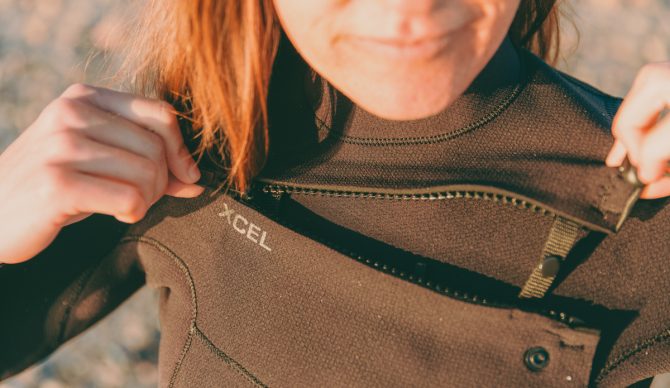
Photo: Jackie Connor//The Inertia
More Top-Pick Women’s Wetsuits
Most Watertight Women’s Wetsuit
Rip Curl Women’s Flashbomb Fusion ($540)
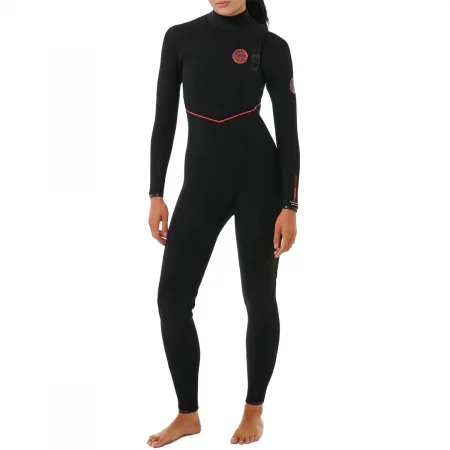
Available In: 3/2mm, 4/3mm,
Materials: 80% Neoprene / 20% Polyamide
Features: No-zip entry, stitch-free welded seams, key loop at chest
Pros: Super warm, fleece lining is cozy, flexible feel
Cons: Zip-free entry is difficult, especially when the wetsuit is dry, fleece lining traps sand
A great choice for those prioritizing warmth and flexibility, Rip Curl’s E7 Flashbomb Fusion features combine sleek, simple design and, best of all, no leaky seams, no hair-catching zippers. Read that again–wettie with no seams. Well, at least 96% of the wetsuit has no seams. And as Rip Curl says: “No seams = no leak = no problem.”
When considering the unusually cold fall and winter paired with some of the largest surf Southern California has seen in decades this past December, the E7 Flashbomb Fusion is by far one of the warmest suits on the market with a solid lining to boot.
The first difference we noticed from a previously owned Rip Curl wetsuit (circa 2013) was that the E7 Flash-Lining was a lot less fuzzy than the original models. The fuzziness was never something we loved, and the new model proved to be more comfortable and offered more stretch than its predecessors.
Despite it being a 3/2mm suit, it kept our tester unflinchingly warm in temps as low as 56 and had minimal leakage. Because this suit insulated her so well, any small amount of leakage was immediately felt through its fleece-lined interior. However, cleaning this suit became a challenge because the fleece became heavier, and sand or gravel would easily stick to the interior.
Zip-free wetsuits have been trending lately, and personally, we think it seems like a weird upgrade, but we were interested in trying it out. We suspected a zip-free wetsuit would be more difficult to put on, and we were proven wrong until we got to the head portion. Getting the body into the suit was easy, but getting the neck section over the head was challenging to get both on and off. With time, it got a little easier, but it was still far more difficult than other suits we’ve owned. It’s kind of a double-edged sword because we know the challenge of putting it on is also what allows it to have a tighter seal and therefore be warmer.
Our tester is a curvier gal, and getting her head down to her hips through the small neck entry felt pretty constrictive and was a bit of a workout to get it on (See: Ace Ventura). Once it’s on, it fits (“like a glove!”) to anyone’s curves, very snug.
If the hassle of a zip-free wetsuit isn’t worth it to you, the O’Neill Hyperfreak suit sports a traditional, zippered chest zip and is much easier to get on and off. The Hyperfreak lacks the flash lining, and you experience some flushing around the neck when duck diving, so it’s not quite as warm as the HeatSeeker, but it is a bit more mobile, resulting in better performance.
The fleece lining makes the suit feel a little heavier when paddling out and around the lineup, but taking off on waves and quickly maneuvering your board make it great for those who want to stay out in the water longer and remain nice and toasty.
Aside from the challenge of getting the suit on, we loved everything about it. As we mentioned, the updated E7 Flash-Lining is incredible and provides the perfect blend of warmth, stretch, and comfort. The suit also features “Flex Energy,” which is a lining on the back and shoulders that generates heat as you move through the water. Although we couldn’t pinpoint the activation during our session, we can vouch for the incredible warmth of the suit.
The quality of the suit is exceptional, and based on past suits we’ve owned from Rip Curl, we have no doubt it will withstand the test of time.
Check price on Cleanline Surf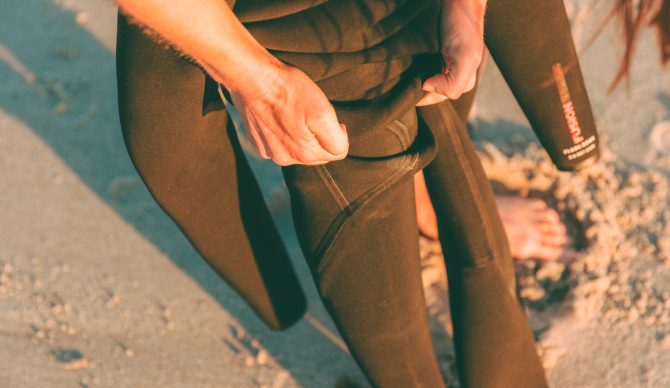
Photo: Jackie Connor//The Inertia
Most Stylish Wetsuit
Roxy Elite ($400)
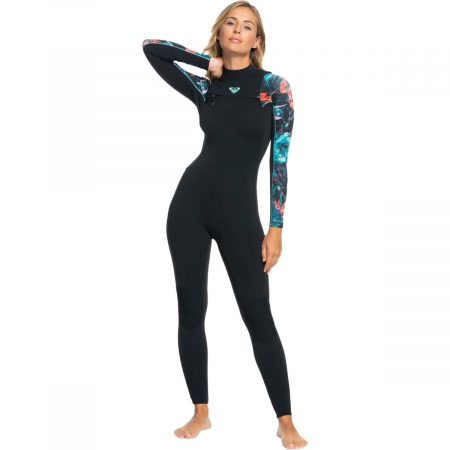
Available In: 3/2mm
Materials: Limestone neoprene made with recycled tires
Features: Free-floating chest-zip, printed exterior, key loop
Pros: Lightweight, colorful designs
Cons: Not the warmest option for borderline conditions, runs small in the shoulders
A little personal flair in a world of black neoprene can go a long way, especially at crowded breaks. The Roxy Elite is a great choice for surfers seeking a decent balance of performance, warmth, and style – this suit is a Jane of all trades in that it has a little bit of everything, but its color choice separates it from the rest.
Designed with StretchFlight Eco neoprene, it provides a decent level of flexibility when paddling and surfing. This suit also saw chillier and more crowded conditions at Trestles and provided the tester with a decent, albeit not exceptional, amount of warmth in 58-degree water, and was lightweight and stretchy enough so paddling and catching waves were easier than wearing a wetsuit focused more on warmth, such as Patagonia’s R2. Ever bring a photographer friend to the beach for a school project, and they can’t pick you out in a crowd? This suit solves that problem.
The chest zip entry minimizes water flushing, keeping surfers warmer during early morning or windy sessions. Beyond its performance, the Elite is arguably one of the most stylish wetsuits on the market. With sleek paneling, flattering contours, and a range of modern color options, it offers a polished, feminine aesthetic that stands out in the lineup. Whether in classic black or one of Roxy’s signature designs, this wetsuit blends function with fashion effortlessly.
When compared to other chest zips, such as the Billabong Furnace or O’Neill Hyperfreak Fire, surfers don’t have to struggle to lock in the zipper because it’s already locked, making it very convenient when in a rush to catch waves.
However, the wetsuit tends to run small, particularly on the shoulders, which may be a concern for those with a more athletic build. While the thermal lining provides decent warmth, it may not be sufficient for colder conditions, making it more suitable for Southern California’s early summer or late fall water temperatures rather than colder waters.
Check price on Backcountry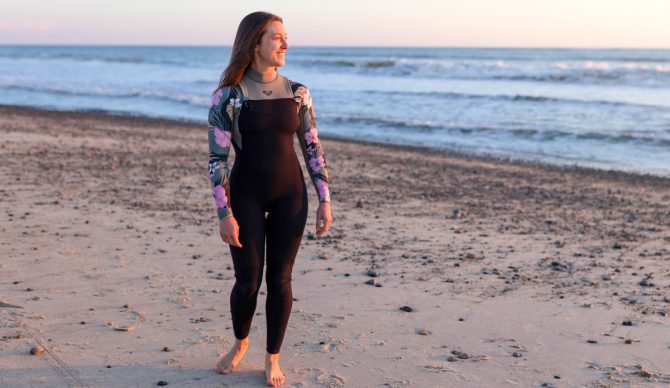
Photo: Jackie Connor//The Inertia
Best Fit/Comfort
O’Neill Hyperfreak Chest Zip ($370)
Available In: 5.5/4mm hooded, 4/3mm, 3/2mm
Materials: Limestone neoprene made with recycled oyster shells and eco carbon black, recycled materials used in wetsuit lining
Features: TechnoButter 3 fully taped seams, lightweight quality construction, and a key pocket on the calf
Pros: Technobutter material is light and flexible, no break-in
Cons: A little wear on the elbows over time
We’ve all spent a session or two shivering in our wetsuit – it’s not fun. Luckily, the O’Neill Hyperfreak puts an end to chilly surfs. The body and legs of the suit are made from Technobutter 3, their exclusive, maximum stretch, water-resistant neoprene. The arms and shoulders are constructed from Technobutter 3X, O’Neill’s pre-stretched neoprene, which is the lightest, most flexible, and softest material they have on offer. Additionally, the chest entry features a floating zipper panel and a flush barrier with drain holes. The result is a warm, comfortable suit with style points to boot.
Although the suit we tested is a 4/3, the comfort and stretch are comparable to a 3/2, without sacrificing warmth. We love how soft and comfy this suit feels, and the head opening for the chest zip doesn’t strangle you when you put it on (a big plus in our book). This suit was comfortable right off the bat and didn’t have a break-in period like most suits, thanks to its pre-stretched neoprene.
The Hyperfreak is an all-around great suit, but it finished behind the Xcel Comp+ because of the awesome performance the Comp provides. In terms of comfort, the suits are comparable, but the Comp+ is a bit more lightweight and stretchy for high-performance surfing, while the Hyperfreak tacks on a bit more warmth.
Check Price on Amazon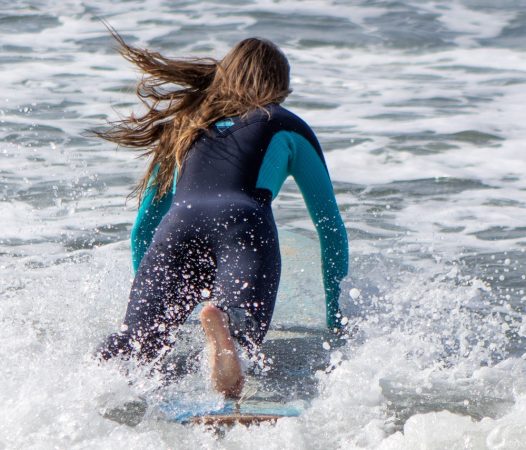
Nothing is more comfortable or stretches better than O’Neill Technobutter. Photo: Jody Marcon//The Inertia
Best Stretch
Feral 3mm2 ($415)
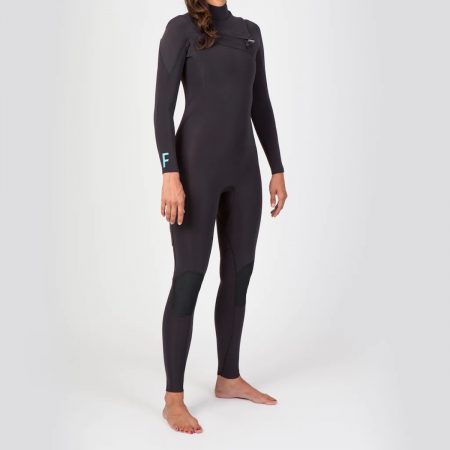
Available In: 5/4mm, 4/3mm, 3/2mm
Materials: 100% Yamamoto neoprene
Features: Inner wrist and ankle seal silicone tape, external thigh key pocket, & strategic seam design
Pros: Super stretchy, inner wrist and ankle seals
Cons: Material is a little thin, runs a bit small
Feral is a brand that wasn’t on our radar until recently, and after taking this suit out for a test run, we’re stoked to have discovered this brand. Based out of the Bay Area in California, the Feral team is no stranger to cold waters, and it shows in the brand’s wetsuit design.
When the Feral 3mm2 Wetsuit arrived in the mail, we couldn’t believe how soft and stretchy the material felt. From our experience with Yamato neoprene, it doesn’t always have the most give, so we were anxious to get the suit in the water and see if it was worth its salt. It is. Made from 100% Yamamoto Japanese rubber, the suit features stretchier neoprene in the neck, shoulders, and arms and lightweight rubber in the body and legs. Additionally, the suit has a smooth, low water-absorption jersey, strategic seam design, critical seam taping, inner wrist and ankle seal silicone tape, PK waterproof zipper with stainless steel pull, and an external thigh key pocket.
Warm and comfortable, with all the bells and whistles, this suit exceeded our expectations. The comfort was next level, and we loved the inner wrist and ankle seals—it reminded us of a dry suit but without the suction cup discomfort. The neoprene feels thinner than other 3/2s we’ve tried, so we worry about how it will fare over time, but it seems well-made, and we have only heard good things, so we’re hopeful. If you prefer a looser fit, consider ordering a size up, but for the most part, sizing is pretty spot on.
check price on FeralWarm and Sustainable
Finisterre Nieuwland 5s Yulex Wetsuit ($545)
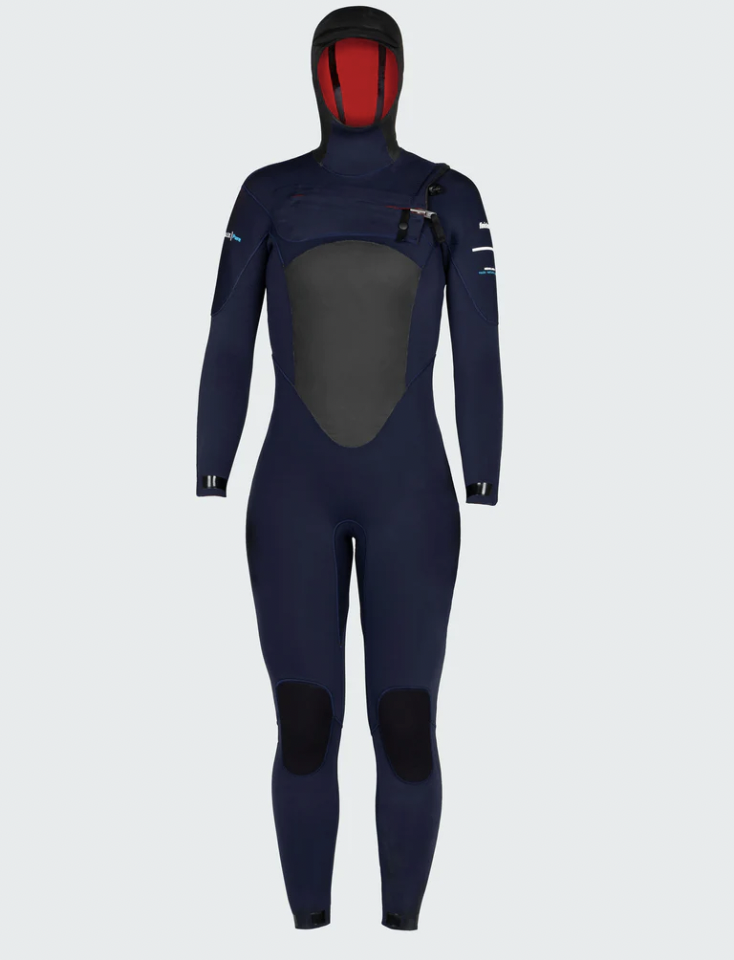
Available In: 3.5/2.5, 4.5/3.5, 5.5/4.5 Hooded
Materials: 85% Yulex natural rubber, recycled polyester fabric
Features: Ankle loops, tight seal around wrists/ankles
Pros: Ankle loops, incredibly warm, built-in hood
Cons: Difficult to get on/off, no small sizes
Finisterre is a brand you may have never heard of, but one you’ll want to put on your radar. In addition to clothes and swimwear, the brand offers a collection of eco-friendly Yulex wetsuits designed for all weather conditions. Our tester got her hands on the Nieuwland 5s for a wintertime trip to New York.
Like many 5/4 wetsuits, the Nieuwland was challenging to get on, but once in the water, it stretched out a bit and got more comfortable. And like many suits, the Nieuwland continued to stretch out and get more comfortable with each wear. A standout feature is the ankle loops. They’re little loops on the exterior of the suit, and they’re a game-changer for assisting in getting the suit on.
The eco-friendly suit is made from a blend of 85% Yulex natural rubber and 15% synthetic rubber by polymer content. It isn’t the stretchiest suit in the world, but it’s stretchy enough to allow for a full range of motion in the arms and legs. It also features double-blind stitching and taped seams throughout, which ensure the suit is warm and durable. In addition, the Nieuwland is extra tight around the wrists to help keep water out, which in turn keeps you warmer. The only downside of this is that it makes the suit more challenging to get off.
Also made from 85% Yulex rubber, the Patagonia R4 is the only other suit on our list that’s as warm as the Nieuwland. Like the Niueuwland, the R4 is stiff at first and can be challenging to put on and take off. Unlike the Nieuwland, the R4 doesn’t get tighter at the wrists and ankles, so it’s slightly easier to put on, and we didn’t notice any extra flushing.
The Nieuwland sports a built-in hood with a bill, which saved our tester during an extra chilly session that involved wind, rain, and hail. Sizing is European, so be sure and check the size chart in order to guarantee you order the correct size. For reference, our tester for this suit is 5’7″, 125 lbs, and typically wears a size six but ordered an eight per the size chart, and it fit perfectly. The Nieuwland is slightly thicker than your traditional 5/4 and, as a result, is an incredibly warm wetsuit. Read our full review of the Finisterre Nieuwland here.
CHECK PRICE ON FinisterreStylish Runner-Up
Billabong Salty Dayz ($290)
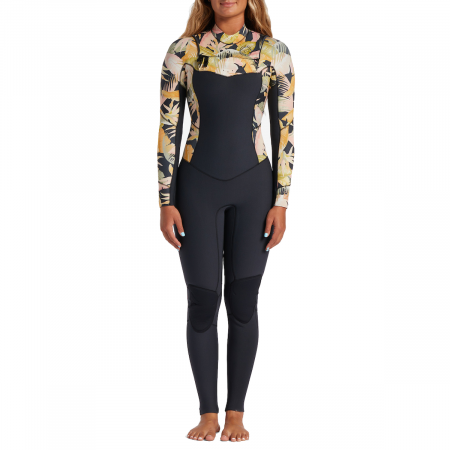
Available In: 3/2mm, 4/3mm
Materials: 100% recycled exterior fabric, partially recycled neoprene SMART foam
Features: Non-toxic, water-based glues, silicon stretch internal jersey, GBS
Pros: Fun pattern
Cons: Feels snug at first
Billabong has a wide selection for women, and their clothes and gear are consistently one of the cutest brands for women. We’ve always been a fan of the look of their wetsuits, but for a while, the sizing/fit was a bit off. Luckily, they’ve got that figured out. We had the luxury of testing out both the Salty Dayz 3/2 and 4/3 in recent years, and we’re a fan of both.
In an effort to be eco-friendly, the Salty Dayz exterior jersey is made from recycled materials—upcycled car tires and neoprene scraps are combined for the foam layer. The suit is lined with Graphene Recycler. Additionally, it features a chest zip entry, glued and sealed exterior seams, durable kneepads, and a place to stash your key. To top it off, the suit features a fun pattern on the chest and sleeves without being overbearing.
The suit is mainly black with a subtle floral pattern on the arms and chest, giving it a fun, feminine flair. Like most 4/3 suits, the Salty Dayz feels a little snug at first, but once you take it out for its maiden voyage, the stretch becomes notable, and overall, it’s a comfortable suit that fits well.
The Salty Dayz fits better in the crotch area, in particular, than Billabong’s Furnace and is more affordable. But, the Furnace is comfortable out of the gates, whereas the Salty Dayz suit takes some time to break in and reach the same level of comfort.
CHECK 4/3 PRICE ON Cleanline Surf CHECK 3/2 PRICE ON Backcountry
High Performance and Surprisingly Sustainable
Picture Organic Equation ($350)
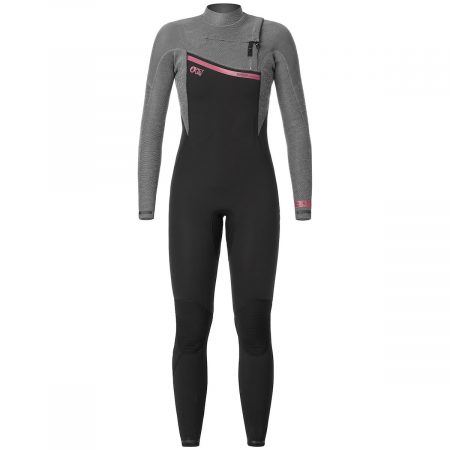
Available In: 3/2mm, 4/3mm
Materials: Made using Eicoprene technology, a non-petroleum synthetic foam derived from a mix of oyster shell powder, limestone, and recycled tires
Features: 3D-Knit construction, WPF lining, & comfort zones to protect ribs while paddling
Pros: Comfort zones to protect ribs
Cons: Not the warmest suit
Picture is one of the newer players when it comes to surf gear and wetsuits, but they’re already doing an impressive job making sustainable suits. Their wetsuits are made using the latest Eicoprene technology, which is a non-petroleum-based synthetic foam that’s derived from oyster shell powder, limestone, and recycled tires. The recycled polyester lining is laminated with Aqua-A, a solvent-free water-based glue that contains zero harmful chemicals. The suits are Bluesign-approved and meet the Global Recycled Standard.
All of Picture’s eco-initiatives sound good on paper, but they’re not worth much if the suit doesn’t perform. We were leery that it wouldn’t be up to par with the other suits, but it’s safe to say that the Equation is a solid suit.
This suit features everything we’re looking for in a solid wetsuit: fully taped seams, glued and blind stitched constructions (GBS), knee pads, a key pocket, and watertight seals. The watertight seals combined with the 3D-Knit construction and WPF lining result in a suit that is nice and toasty. It’s not the warmest suit on this list, but it does the job. It also has comfort zones to protect the ribs while paddling, which is something we haven’t seen in a suit before but really liked. The construction seems solid, and this is a suit we see being a part of our surf essentials for years to come.
Woman-Owned and Designed
Kassia + Surf La Luna ($380)
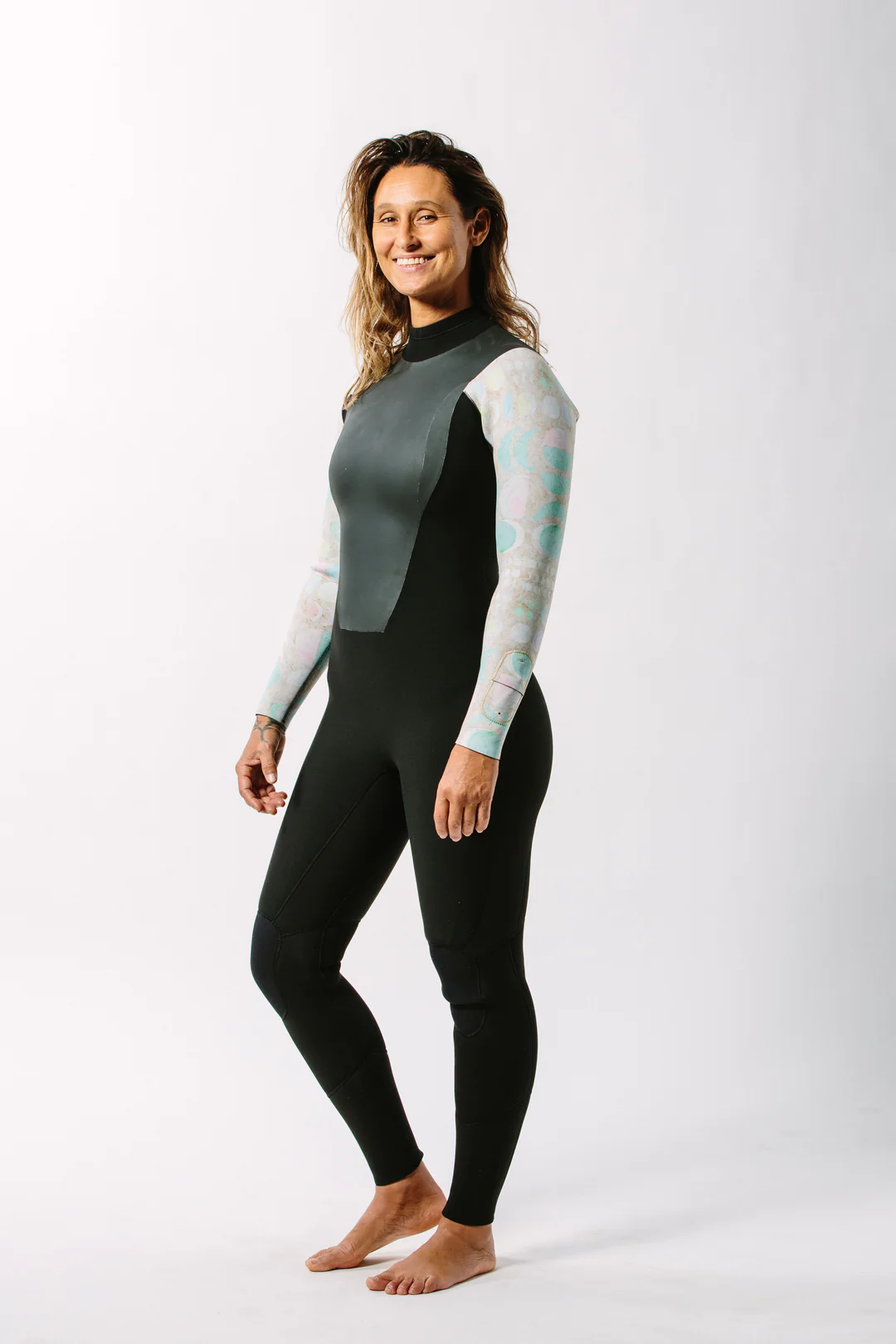
Available In: 5/4mm, 3/2mm
Materials: Recycled thermal heat lining, Earth First Construction Elements
Features: Smoothie V over chest/back, key stash pocket on left arm
Pros: Smoothie/jersey combo, back zip entry
Cons: Double neck flap enclosure takes some getting used to
From the mind of professional surfer Kassia Meador, the La Luna wetsuit is designed with warmth and comfort in mind. The 3/2 and 4/3 mm suits feature a smoothie/jersey combination that offers maximum warmth and comfort.
Unlike other, older models of Kassia + Surf wetsuits, the La Luna is comfortable out of the gates. The double-neck flap enclosure took a little getting used to in terms of comfort, but we appreciate that it works to prevent cold water from entering through the neck. This suit also sports a back zip, which is rare these days and is something that we’re actually a big fan of because it makes it easier to get in and out of.
In a lot of ways the La Luna is the polar opposite of Flashbomb but has similar goals. The Flasmbomb utilizes zipper-free technology to prevent water from entering the suit, especially at the neck, whereas the La Luna uses the double neck. The Flashbomb is more comfortable in the neck region once it’s on, but it’s much more of a battle to get it on and off.
Created with the environment in mind, the suit sports a recycled thermal lining on the torso for added warmth. Additionally, Earth First Construction elements are woven through the suit to conserve energy, save water, and keep harmful chemicals from entering the ocean. Other thoughtful features include fabric kneepads, a smoothie V over the chest and back, and a key stash pocket on the left arm.
CHECK PRICE ON BackcountryMost Convenient Wetsuit
Ho Stevie! Women’s Surfing Wetsuit ($200)
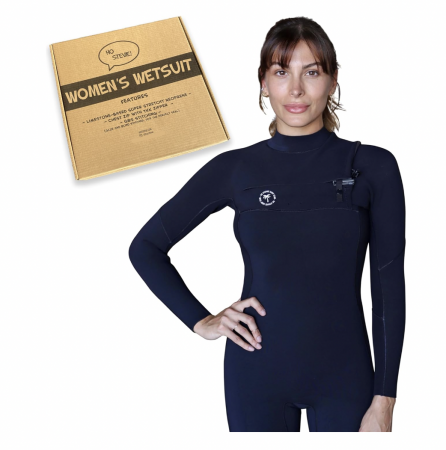
Available In: 3/2mm, 4/3mm
Materials: Limestone-based neoprene
Features: GBS seams, full seam taping, key loop in chest zip
Pros: Fast delivery and decent quality for the price
Cons: Very basic, arms are shorter than usual
Surfers with Amazon Prime will be stoked if they are in a pinch and need a decent wetsuit fast. If you order and have Prime, expect the Ho Stevie! Women’s Wetsuit to be at your doorstep the next day– a fantastic factor if you need a wetsuit fast and don’t want to spend a ton of money. Though we were a little skeptical at first, Ho Stevie! offers a decent limestone neoprene wetsuit that is glued and blind stitched, but has minimal lining, which decreases the warmth factor.
The stretch factor is where this suit shines – soft and flexible, the suit worked well in waves that require more paddling, and quickly putting on and taking off the suit. The neck area and chest zip didn’t have many leaks during duck diving due to the added cinch strap, making the chest adjustable. Another small but mighty benefit to this suit: the zipper starts from within the chest zip, meaning you don’t have to fight two sides of the chest zip together to close it. When comparing it to the Roxy Elite suit, the zippers are a great bonus, but the Roxy Elite is a little warmer due to the heftier lining.
The key loop is conveniently located inside the chest zip, so it’s easy to unlock your car without removing the wetsuit entirely.
Although Ho Stevie! is updating their wetsuit designs, both of our testers who tried this suit found the sizing to be off. For one of our testers, the arms on this model were a little too short in length. She is normally a size 8, but needed a size 10 so the arm length would have the right coverage. Our other tester is normally a size 6, but found the size 10 to provide her with the best fit – we strongly recommend sizing up when purchasing this suit.
Check Price on Amazon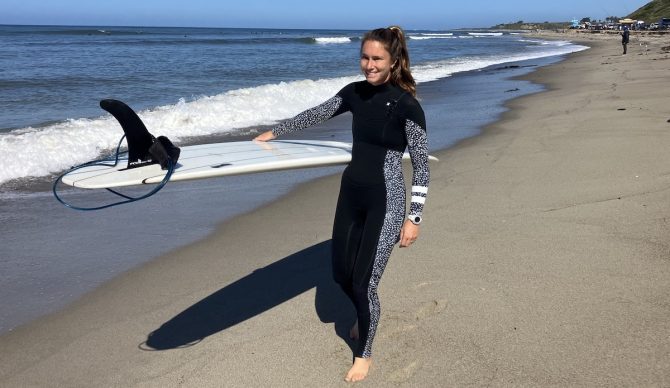
The Hurley Plus Printed Fullsuit is both cute and comfortable. Photo: Sarah Parsons//The Inertia
Honorable Mentions
Over the past few years, we’ve tested a lot of wetsuits. And no, we simply couldn’t include all of them here. With that in mind, here are a few more options that almost made the cut.
First off, our previous Best Overall Wetsuit, the Xcel Comp. This year, Xcel revamped its entire wetsuit line and introduced the Comp+, an upgraded version of the Comp. Needless to say, we were quite impressed and awarded the Comp+ the Best Performance wetsuit. The suits are so similar, it didn’t make sense to take up two spots on this list between the two of them, but if you’re interested in the performance of the Comp+ at a slightly more affordable price point, the Comp is where it’s at. For a bit more warmth, check out the Comp X. Read our full review of the Xcel Comp here.
Billabong’s Furnace Comp is another one we’d like to mention. It’s a slightly slimmed-down version of the classic Furnace, the sustainable version of which, the Furnace Natural, we named Best Overall, above. If you’re ok with a bit less warmth and prioritize flexibility, this is a great choice.
We’re also big fans of the Hurley Advantage Plus and Plus Printed women’s wetsuits. With great flexibility and cute styling, these suits are both top-choices in our books, but at the moment, Hurley is sold out of all women’s wetsuits. We’ll update this review if and when that changes. Read our full review of the Hurley Plus Printed here.
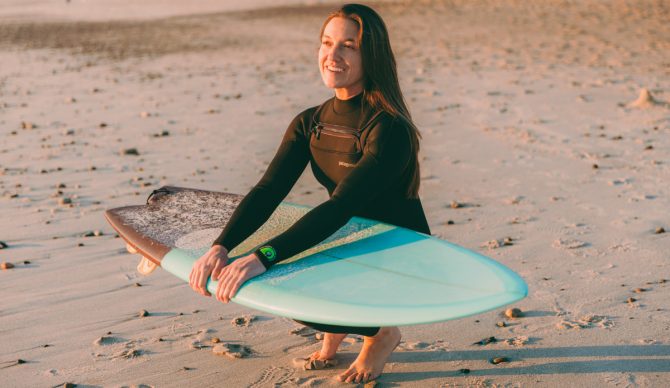
Patagonia’s new line of Regulator wetsuits brings Yulex natural rubber that’s finally on par with the best traditionally-made wetsuits in terms of stretch and flexibility. Photo: Jackie Connor//The Inertia
Best Women’s Wetsuits Comparison Table
| Wetsuit | Price | Available In (mm) | Materials | Features |
| Billabong Furnace Natural | $400 | 4/3mm, 5/4 hooded | Natural Hevea rubber, 100% recycled textiles for inner and outer lining | Sustainable natural rubber, exterior seam seal, key loop in chest zip |
| O’Neill Hyperfreak Fire | $440 | 3/2mm+, 4/3mm+ | Limestone neoprene made with recycled oyster shells and eco carbon black, recycled materials used in wetsuit lining | Extra .5mm of thickness, exterior sealed seams, key pocket on calf |
| Patagonia Women’s Regulator | $509 | R1 (3/2.5), R2 (3.5/3), R3 (4.5/3.5), R4 (5.5/4) | Yulex Natural Rubber, 100% recycled nylon | Free-floating front zipper, key loop in front zip, Patagonia repair policy |
| Roxy Prologue | $230 | 3/2mm, 4/3mm | Limestone neoprene made with recycled tires | Back zip, smoothie panels on chest and back, key loop in back zip |
| Xcel Comp+ | $370 | 4/3mm, 3/2mm, 5/4mm hooded | Nanoprene Light Japanese limestone neoprene, dope-dyed yarn | Key loop in front zip, lightweight thermal lining throughout |
| Rip Curl Flashbomb Fusion | $540 | 3/2mm, 4/3mm | 80% Neoprene / 20% Polyamide | No-zip entry, stitch-free welded seams, key loop at chest |
| Roxy Elite | $400 | 3/2mm | Limestone neoprene made with recycled tires | Free-floating chest-zip, printed exterior, key loop |
| O’Neill Hyperfreak | $370 | 5.5/4mm hooded, 4/3, 3/2 | Limestone neoprene made with recycled oyster shells and eco carbon black, recycled materials used in wetsuit lining | TechnoButter 3 fully taped seams, lightweight quality construction, key pocket on calf |
| Feral 3mm2 | $415 | 5/4, 4/3, 3/2 | 100% Yamamoto neoprene | Inner wrist and ankle seal silicone tape, external thigh key pocket, & strategic seam design |
| Finisterre Nieuwland 5s Yulex Hooded Wetsuit | $545 | 3.5/2.5, 4.5/3.5, 5.5/4.5 Hooded | 85% Yulex natural rubber, recycled polyester fabric | Ankle loops, tight seal around wrists/ankles |
| Billabong Salty Dayz | $290 | 3/2mm, 4/3mm | 100% recycled exterior fabric, partially recycled neoprene SMART foam | Silicon stretch internal jersey, GBS seams, fun prints |
| Picture Organic Equation | $350 | 3/2mm, 4/3mm | Eicoprene: a non-petroleum synthetic foam derived from a mix of oyster shell powder, limestone, and recycled tires | 3D-Knit construction, WPF lining, & comfort zones to protect ribs while paddling |
| Kassia + Surf La Luna | $380 | 5/4mm, 3/2mm | Recycled thermal heat lining, Earth First construction elements | Smoothie V over chest/back, key stash pocket on left arm |
| Ho Stevie! Women’s Wetsuit | $2oo | 4/3, 3/2 | Limestone-based neoprene | GBS seams, full seam taping, key loop in chest zip |

Some of the best wetsuits in the industry. Photo: Rebecca Parsons//The Inertia
How We Tested The Best Women’s Wetsuits
The Testers
Our lead testers for this review are Rebecca Parsons and Jackie Connor.
Jackie has been surfing SoCal’s coast for over 20 years despite originating from the South. She loves a good log day at San Onofre, but can’t get past shortboarding all over O.C., with Trestles being her main spot. Jackie is 5’3”, weighs about 128-130 pounds, and typically wears a size 8. Her design tastes are simple and minimalistic, but she enjoys a good splash of color every once in a while to stand out among a sea of all black.
Born and raised in Orange County, California, with a short stint in Santa Cruz for college, Rebecca Parsons has worn her fair share of wetsuits over the years. And one thing she’s learned through her experience is that not all wetsuits are created equally. Some are ultra-warm. Some are comfortable. Others are not. Some withstand the test of time. Some are stylish. You get the picture. She’s 5’7”, 125 lbs. with an athletic build. Her legs are a little on the long side, but in general, she’s proportional, and size 6 tends to get the job done.
The Process
Obviously, everyone is entitled to their own opinion, and the perfect wetsuit is going to vary from person to person. We tried to consider factors that most people are looking for in a wetsuit. Warmth. Stretch/comfort. Durability. Style. Materials. Special features. Anything that may contribute to the suit raises the bar for wetsuits.
We reached out to the top wetsuit manufacturers in the business and asked them to send us their best wetsuits. If you’re wondering if this is a pay-to-play type of guide, it’s not. No company paid to be included in this guide, and each review is simply based on our experiences with the suit.
In order to test each suit, you guessed it, we surfed. Not only did we surf, but we jumped in unheated pools, wore them scuba diving, and shoved ourselves in and out of them multiple times (because a huge factor of a good suit is how easy it is to take on/off).
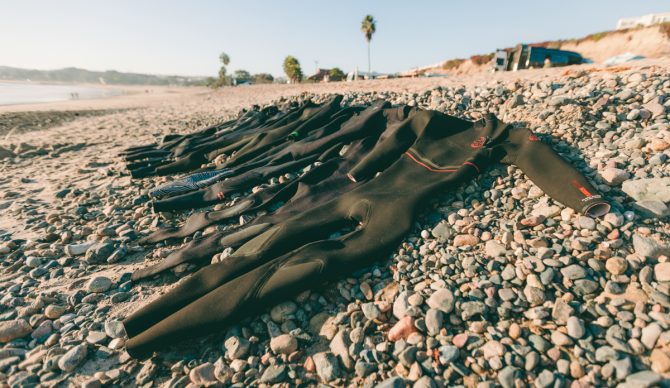
Testing day on the cobblestones of San Onofre. Photo: Jackie Connor//The Inertia
Testing Conditions
We mainly tested these wetsuits in the beach breaks of Newport and Huntington Beach, and the rock reefs at Trestles and San Onofre. We surfed on sunny, overcast, and windy days with water temps ranging from 56 to 61 degrees Fahrenheit for at least an hour and a half, and up to three hours per session if the waves were really firing. The late 2024 to early 2025 season has seen temperatures dipping a little below normal thanks to upwelling and strong Santa Ana offshore winds, so each of what would be considered a 3/2 or 3/2+ wetsuit’s standard warmth limit was challenged.
Recent Updates
We first published this review in December 2021. In June of 2023, we did some housekeeping and dropped some of the suits that we didn’t love or were no longer available. Over the summer, we had the opportunity to try out the newly launched Patagonia R2 Regulator, which we added to the review. We updated this review in November of 2024, adding more comparison info to help you decide between all these great options.
Our most recent update, in the spring of 2025 after a winter of putting some of our favorite wetsuits to the test in colder-than-usual conditions, takes input from a new tester, Jackie Connor, and merges her findings with those of our original tester, Rebecca Parsons, to give multiple opinions on our top-pick wetsuits. This gives us a more diverse set of information from women with different surfing styles and body shapes, so we can provide you with the most complete picture of the best wetsuits as possible.
Editor’s Note: Water a little warm? Grab yourself one of The Women’s Best Springsuits. Just need a top? We’ve got The Best Women’s Wetsuit Jackets. Simply need some sun protection. The Best Surf Suits for Women will do the trick. Bikini weather? Check out The Best Women’s Swimsuits for Surfing (That Will Stay Put). For more surf gear reviews, click here.
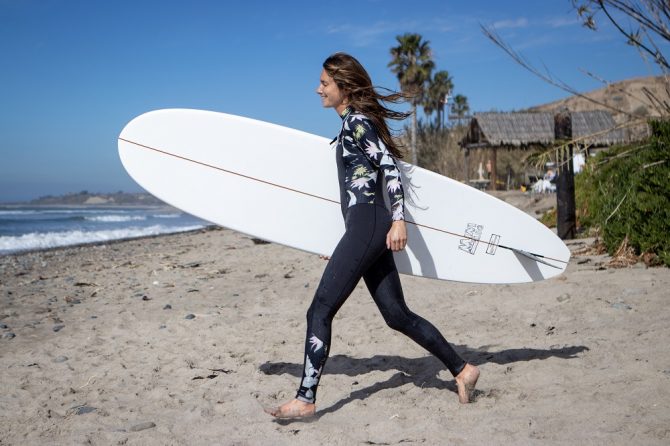
The flair of Billabong’s Salty Dayz feels right at home at SanO. Photo: Jody Marcon//The Inertia
Women’s Wetsuits Buyer’s Guide
Wetsuit Fit
Fit is one of the most important factors to consider when purchasing a wetsuit. If you’re buying in person, we highly suggest hopping in a dressing room and trying on the suit. Yes, it’s a pain, but it’s worth it for a good fit. No matter how incredible the suit is, if it doesn’t fit you well, it’s not going to get the job done.
In general, wetsuits should fit snugly, but not so tightly that your range of motion is limited. Think of it as your ‘second skin’ while surfing. The neoprene will loosen up in the water and will stretch a bit with time, so it should definitely feel tight when you first try it on.
Our testers really gravitated toward Billabong’s Furnace Natural wetsuit for its mobility, lightweight, and stretch factor, but the standout feature was this wetsuit’s ability to mold to unique body shapes. Our main tester for this suit is 5’3”, weighs about 128-130 pounds, and typically wears a size 8. Women with curves might enjoy this suit a little more because there is more stretch in the hips and chest, whereas other suits, like the Rip Curl E7 Flashbomb, though very toasty, have areas of tightness around the thighs. The Billabong Furnace Natural felt most true to size, was easy to slip on and off, and kept our tester pretty warm while still remaining flexible in all curvier areas.
Patagonia’s R2 wetsuit fit well within the curve requirements and, as an added bonus, kept our tester very warm throughout the oddly chillier winter season this year. There was no pinching in the thighs or the neck. The only drawback was the water weight the suit carried, making it a little more challenging to hoof the walk back to her car at Trestles.
If you’re ordering online, reference the size charts and make sure the company has a solid return policy in case it’s not a good fit. If you find a winner, you might want to consider sticking with that brand down the road.
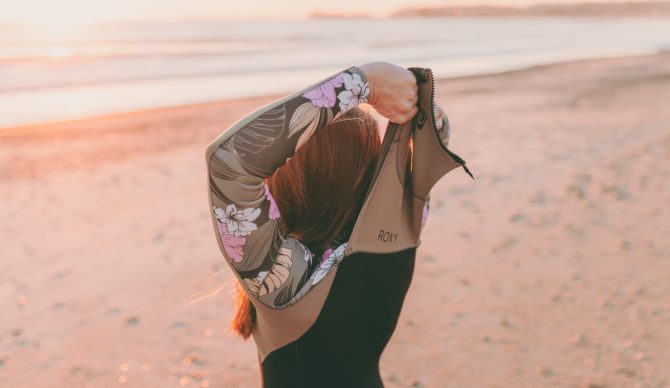
Roxy’s Elite wetsuit has a free-floating chest zip, which makes entry a bit easier. Photo: Jackie Connor//The Inertia
Wetsuit Entry Systems
There are three main wetsuit zipper systems: chest zip, back zip, and zipless. Back zip wetsuits were the original wetsuit design and have a long, center zipper running up the length of the back. Back zip wetsuits like the Kassia + Surf La Luna are typically the easiest to put on, but they aren’t as warm as the other two options because they let more water into the suit.
Chest zip or front zip wetsuits like the Xcel Comp are the most common type of wetsuit these days. They have a portion that you pull over the neck and then zip across the chest. Finally, zipless wetsuits like the Rip Curl E7 Heatseeker Flashbomb have a wider opening at the shoulders but no zippers. They can be more challenging to put on, but you don’t have to worry about zippers digging in, and they can be more flexible.

O’Neill’s Hyperfreak Fire delivers with tons of warmth and top-tier stretch despite the thicker lining. Photo: Jackie Connor//The Inertia
Warmth vs. Stretch
Warmth and stretch are a bit of opposing forces when it comes to wetsuits. The warmer the suit, the thicker and less stretchy it will be. In this review, we did our best to find suits that were the best of both worlds.
Some suits on this list, like the Finisterre Nieuwland 5s Yulex Hooded Wetsuit, prioritize warmth, and others, like the Feral 3mm2, prioritize stretch. Before purchasing a suit, it’s important to think about what type of surfer you are. If you tend to run cold and find it ruins your sessions, it could be worth sacrificing some stretch for added warmth.
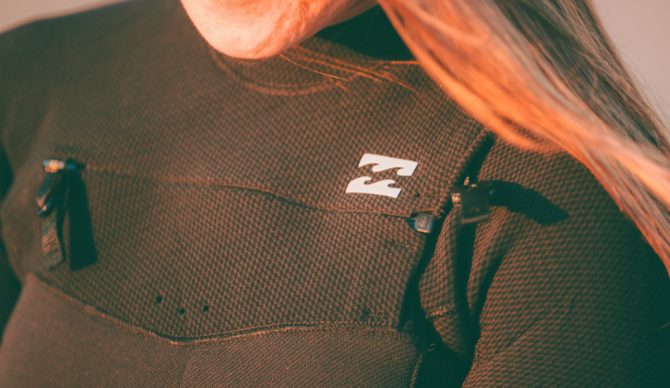
New this year, Billabong is producing its suits with natural rubber from Hevea trees. Photo: Jackie Connor//The Inertia
Sustainable Wetsuits
For the longest time, eco-friendliness simply wasn’t an option when it came to wetsuits. That was until 2016, when Patagonia dropped its Yulex wetsuits, the world’s first wetsuits made from natural rubber. Since Patagonia launched its sustainable wetsuit, other companies have followed suit and gotten creative in coming up with sustainable alternatives for wetsuits. Some brands have gone the natural rubber route, using Yulex or natural rubber made from Hevea trees (Yulex is just a brand name for this Hevea rubber material).
From an environmental standpoint, natural rubber has the smallest impact on the environment, making it the best option for the planet, which is one of the reasons the Patagonia R2 Regulator is the most sustainable wetsuit we tested. The other reason is Patagonia’s Ironclad Guarantee, where they will fix your wetsuit for you, keeping it in the water for longer.
After that, wetsuits produced from recycled materials like old tires, oyster shells, etc., are the next best option, and they’re usually mixed with limestone neoprene.
Limestone neoprene by itself is likely better for the environment than traditional neoprene, which is derived from crude oil, but the process of creating limestone neoprene is very energy-intensive. Recent findings have even suggested that limestone neoprene may be less environmentally friendly than traditional neoprene due to how much energy is required to make neoprene out of it.
As far as performance is concerned, limestone neoprene is probably the top performer, with suits made from recycled materials following closely behind. When it comes to sustainable options, Yulex and natural rubber has historically been the worst performance-wise, but the technology continues to improve, and the most recent natural rubber suits (from Patagonia and Billabong) have improved their stretch in leaps and bounds, proving that natural rubber can be just as high-performing as the best traditional and limestone-neoprene wetsuits in the industry. In testing this season, Billabong’s Furnace Natural, made with natural rubber, was one of the top performers for stretch and flexibility, which, combined with other factors (like its sustainability), earned it the Best Overall award.

Surf check in the Hurley Plus Printed Fullsuit. Photo: Sarah Parsons//The Inertia
Wetsuit Durability
Wetsuits are pricey, so you’ll want a suit that’s going to last you more than a season. Depending on how well you take care of it and how frequently you surf, a good suit like the Billabong Furnace Natural should last you at least a couple of years. Rip Curl’s Flashbomb Fusion, a new design that uses seam tape and glue instead of stitching, promises to last much longer than that with its supposedly leak-proof design. Worth noting, a suit that is flexible and has a little more give may not last as long as a more rigid suit, so you’re dealing with a bit of a double-edged sword. From an environmental standpoint, the longer a suit lasts, the better. Considering we tested these suits over the course of a few months, durability will be based on early impressions of the quality and how we foresee the suits lasting over time. As we continue to test these wetsuits, we’ll keep this article updated with any durability issues that arise.
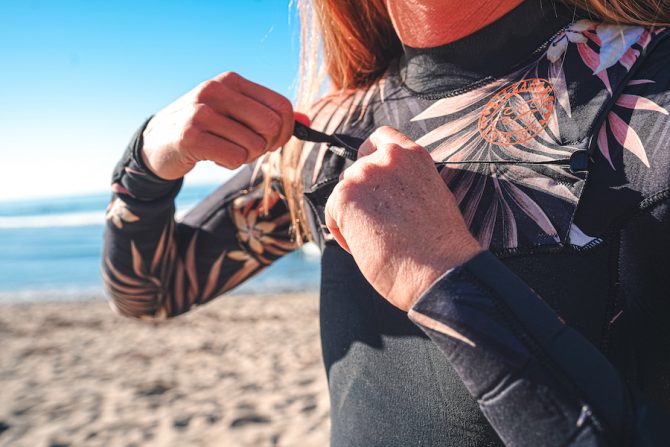
Key pockets, often located in the front zip of the wetsuit, are a great extra feature. Photo: Kelin Victoria//The Inertia
What Other Factors Matter in a Wetsuit?
Warmth
There are a lot of factors to consider when buying a wetsuit. Warmth is one of the most important factors when selecting a suit. If it’s not going to keep you warm, then there’s no point. Obviously, the thickness of the suit is going to affect the warmth, so it’s important to know what is appropriate for your region. Consult a wetsuit thickness and temperature chart or chat with friends in your local lineup before selecting a suit. For example, the Roxy Prologue Back-Zip will do just fine for Southern California, but if you’re venturing somewhere like Alaska, you’ll want a thick suit like the Finisterre Nieuwland 5s Yulex Hooded Wetsuit.
Longevity in warmth has always been a key factor with our tester’s wetsuit preferences–how long will this suit keep me in the water? That is the question we all ask ourselves, because more time in the water equals more waves, right? Neoprene thickness is just one aspect of a suit’s warmth, and we did our best to compare suits of the same thickness in our testing.
As far as the warmest 3/2mm wetsuit goes, it was a close call between Patagonia’s R2 and Rip Curl’s Flashbomb Fusion in 3/2mm – both were very warm, and our tester never even thought to reach for one of her 4/3mm wetsuits during testing. Both suits have an added layer of material to keep our tester warmer for longer. Patagonia’s R2 was perfect for chillier overcast days, and the Rip Curl Flashbomb’s zipperless entry made it the first choice for our tester when the wind was blowing. The Rip Curl’s fleece-lined layer is as cozy as it looks, with the only downside of it being on the heavier side and its miraculous ability to capture sand and gravel. Patagonia’s R2 has a thicker, but less plush lining, and still manages to be a strong warmth contender.
Style
It may sound silly, but we care what our suits look like. When we’re shelling out a few hundred bucks for a suit that we’ll be wearing multiple times a week for years, we want it to have a little flair. Plus, when we’re wearing a suit with a splash of color, we feel a little less like shark bait. The most stylish wetsuit we tested this season is the Roxy Elite.

The Xcel Comp Wetsuit comes in bright and fun colors. Photo: Rebecca Parsons//The Inertia
Key Pocket
When purchasing a wetsuit, we also consider whether it has a key pocket. Our personal preference is an external calf pocket, with a key loop inside for added security, like that on the Feral wetsuit. Internal key loops work well, too, but we have a slight fear that our key is going to twist sideways and stab us. Most internal key loops are located in the chest zip, like the one on the Salty Dayz 4/3. We recognize that most cars these days use fobs, and as such, the need for a key pocket is becoming less and less necessary, but we still like having the option.
Zipper Design
Another factor to consider when buying a wetsuit is the zipper design. Is it a back zip? A chest zip? Zip free? Back zips at this point are almost obsolete, but we still kind of like them for the ease of entry, which can be especially important if you have mobility problems. Chest zips seem to be the go-to these days.
Zip-free is a newer design, but we’re still on the fence about it because wetsuits are already difficult enough to put on, and zip-free suits definitely up the difficulty. That said, having no zippers to dig into your chest while paddling is a point in their favor, so pick your poison. The only zip-free wetsuit we tested was the Rip Curl Flashbomb Fusion – it was more challenging to get on, but was comfortable, and minimal water was able to seep in thanks to the lack of zippers.
Some zippers require you to put two pieces together, some are already attached on one end, and some require a snap to seal. Lots to consider, but like most things, it ultimately comes down to comfort. Finally, seams and taping are other factors to consider.
Hoods
Although most wetsuits don’t include a hood, some of the colder models, like 5/4s and 6/5s, do include hoods, as well as select 4/3 suits. When you’re in sub-50-degree water, you’ll want a hood. When we were testing the Finisterre Nieuwland 5s Yulex Hooded Wetsuit at Rockaway Beach in the wintertime, the hood was essential. Options include wetsuits with built-in hoods, detachable hoods, and separate hoods. It really just comes down to personal preference.

The Patagonia R2 Regulator suit is one of the most eco-friendly suits on the market. Photo: Sarah Parsons//The Inertia
How Do I Take Care of My Wetsuit?
Taking good care of your wetsuit is essential to ensure it has as long of a life as possible. After each use, be sure and rinse your wetsuit with fresh water and hang it to dry. In addition to freshwater rinses, it can be helpful to rinse your suit with a wetsuit cleaner every few months to keep it smelling fresh and feeling good. And if a tear occurs, fix it before it gets bigger!
How Long Should My Wetsuit Last?
Forever. Just kidding, we wish that were true. At a minimum, your wetsuit should last you a year. And that’s if you surf every single day. In general, wetsuits should last a couple of years before they thin out or get holey. We’ve had suits that have hit the four-to-five-year mark, but those are the best of the best. Oftentimes, if it’s a thicker suit like a 4/3 or 5/4 mm suit, it’ll become our warmer water suit after a few years. Even though it’s lost some of its warmth, there’s usually still enough for it to serve the purpose of a 3/2. To help your wetsuit last as long as possible, be sure and take good care of it: Wash it regularly, re-seal your wetsuit seams when they start to split, be careful when taking your wetsuit on/off, and avoid changing directly on asphalt.
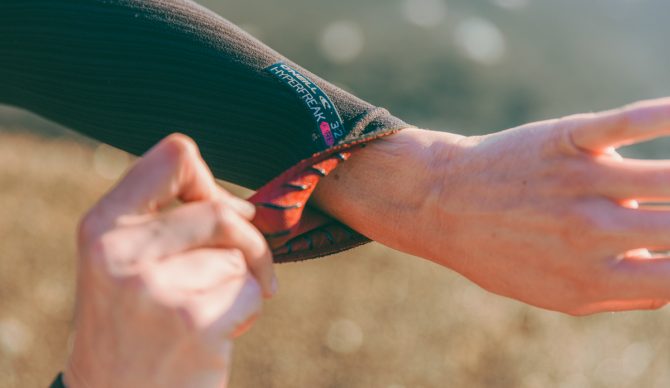
Rubberized cuffs on the O’Neill Hyperfreak Fire keep the wetsuit sleeves from riding up and help prevent water entry as well. Photo: Jackie Connor//The Inertia
What Thickness Wetsuit Should I Get?
Wetsuit thickness is dependent on a few things: Where you surf, what time of year you surf, and how hot/cold you run. In Southern California, we tend to wear a 4/3 during the worst of winter and a 3/2 throughout shoulder season. When we venture north, we’ll either wear my 4/3 with booties and a hood or switch to my 5/4. Below is a general guide based on water temperatures.

The above is just a general guideline to abide by, there are plenty of other factors to consider when choosing the thickness of your suit. Thicker suits tend to be more work to paddle in, but they will also keep you warmer—you have to decide which is your priority. Wind and sun are also factors to consider. If it’s extra windy or not very sunny, it’ll make you feel colder, regardless of the water temp. Wetsuits that have a “smoothie” panel on the chest area can be helpful in blocking wind.

The Furnace Natural from Billabong combines top-tier stretch, warmth, and sustainability at a great price, which is why we named it the Best Overall Women’s Wetsuit. Photo: Jackie Connor//The Inertia
Another factor to consider is how active you are in the water. If you tend to do a lot of paddling with minimal downtime, then you may want to opt for a thinner suit as you’ll run warmer. If you’re on the other end of the spectrum and find yourself sitting around a lot between sets, then you could benefit from a thicker suit. Because we have multiple suits, we tend to check conditions before we head out, and if it’s a bigger day that we know is going to require a lot of paddling to make it back out between sets, then we will typically pick a 3/2. If it’s a mellow 1-2 feet that will require minimal paddling, then you’ll usually find us reaching for a 4/3.
If you’ve made it through all 8,000-plus words of this article, then thanks for reading. Although opinions will vary from person to person, we hope this guide was helpful and will take some of the stress out of shopping for your next suit. We’ll do our best to update this article as suits go in and out of stock online, and will add updates if we’re able to test additional suits or should any problems arise regarding durability. See you in the water.
Return to Top Picks | Return to Comparison Table
Editor’s Note: Check out our full collection of surf gear reviews. For other gear reviews and features on The Inertia, click here.


